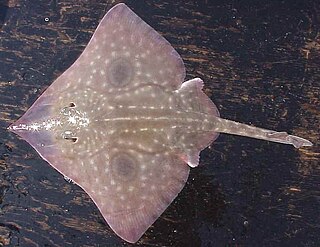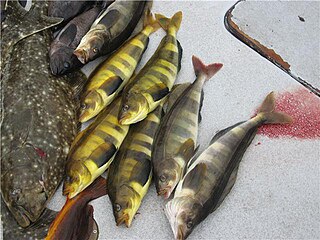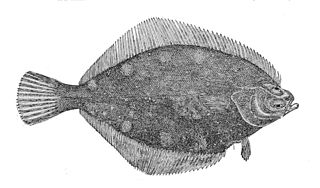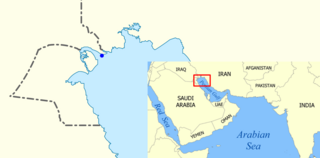
The Pacific ocean perch, also known as the Pacific rockfish, rose fish, red bream or red perch, is a fish whose range spans across the North Pacific : from southern California around the Pacific rim to northern Honshū, Japan, including the Bering Sea. The species appears to be most abundant in northern British Columbia, the Gulf of Alaska, and the Aleutian Islands.

Bathyraja is a large genus of skates in the family Arhynchobatidae.

The barndoor skate is a species of marine cartilaginous fish in the skate family Rajidae of the order Rajiformes. It is native to the northwestern Atlantic Ocean, and is found from the Grand Banks of Newfoundland and the southern side of the Gulf of St. Lawrence south to North Carolina. The fish is one of the largest skates found in the North Atlantic Ocean, reaching lengths up to 1.5 m (5 ft). It is carnivorous, feeding on invertebrates and other fish found near the sea floor.

The shortraker rockfish is an offshore, demersal species of marine ray-finned fish belonging to the subfamily Sebastinae, the rockfishes, part of the family Scorpaenidae. It is found in the northern Pacific Ocean.

The deepsea skate is a species of softnose skate, in the family Arhynchobatidae, found in deep water from 362 to 2,906 m, usually on the continental slope. They are distributed from off northern Baja California around Coronado Island and Cortes Bank, north to the Bering Sea, and west to Japan. There have also been sightings north of Darwin Island within the Galapagos Marine Reserve in 2015. This was the first record of the Deepsea Skate being found in the tropical eastern Pacific Ocean. It is fairly common below 1,000 m, and is taken as bycatch in deepwater trawls and traps. The species name abyssicola comes from the Greek abyssos meaning "bottomless", and cola meaning "living at depths".
The whitefin swellshark is a species of catshark, belonging to the family Scyliorhinidae, endemic to southeastern Australia. It is found 126–554 m (413–1,818 ft) down, on the outer continental shelf and upper continental slope. Reaching 1.1 m (3.6 ft) in length, this shark has a very thick body and a short, broad, flattened head with a large mouth. It is characterized by a dorsal color pattern of dark saddles and blotches over a brown to gray background, and light fin margins. When threatened the whitefin swellshark can inflate itself with water or air to increase its size. Reproduction is oviparous. As of 2019 The International Union for Conservation of Nature (IUCN) has assessed this species as Critically Endangered due to the significant decline of the population.

The ocellated electric ray or bullseye electric ray is a species of electric ray in the family Narcinidae, native to the shallow inshore waters of the eastern central Pacific from the Gulf of California to Ecuador. Reaching 25 cm (9.8 in) in length, this species has a rounded pectoral fin disc and pelvic fins with convex margins. Its short and thick tail bears two dorsal fins and terminates in a triangular caudal fin. The ocellated electric ray is named for the distinctive large eyespot on the middle of its disc, consisting of a black or yellow center surrounded by concentric rings. Its dorsal coloration is otherwise highly variable, ranging from plain to ornately patterned on a light to dark brown background. The front part of its disc is darker brown.

The big skate is the largest species of skate in the waters off North America. They are found along the Pacific Coast from Alaska to Baja California, typically from the intertidal zone to a depth of 120 m (390 ft), and feed on benthic invertebrates and small fishes. They are unusual among skates in that their egg cases may contain up to seven eggs each. This species is one of the most commercially important skates off California and is sold for food.

The shadow trevally, also known as the shadow kingfish, twothread trevally or Aldabra trevally, is a species of inshore marine fish in the jack family Carangidae. The species is patchily distributed throughout the tropical and subtropical waters of the Indian and west Pacific Oceans, from South Africa in the west to Japan and Samoa in the east, reaching as far south as Indonesia and New Caledonia. It is most easily distinguished from similar species by as series of dark rectangular blotches under the second dorsal fin, giving a 'shadowed' appearance, from which its common name is derived. The shadow trevally is a reasonably large fish, growing to 85 cm in length and at least 2.6 kg in weight. It inhabits shallow coastal waters, including reefs, bays, and estuaries, where it takes small fish and benthic crustaceans as prey. Nothing is known of the species' ecology and reproductive biology. It is of little importance to fisheries, and is occasionally taken by bottom trawls and other artisanal fishing gear.

Bathyraja mariposa, sometimes referred to as the butterfly skate, is a species of skate found in the Aleutian islands. It is overall a medium-brown color, lacks thorns on the disc and has indistinct thorns on the tail. It was discovered in 2002 during a National Marine Fisheries Service survey, and first described in 2004. The holotype specimen is held at the University of Washington. Its species name "mariposa" derives from the Spanish word for butterfly, although several other species are sometimes referred to as the "butterfly skate."

The Aleutian skate is a species of skate in the family Arhynchobatidae. It lives in depths ranging from 15 to 1602 meters in North Pacific Ocean from northern parts of Japan to the Aleutian Islands and southeastern Alaska. It has maximum total length of 161 centimeters. It is the most abundant species of the Bathyraja genus in the eastern Bering Sea slope and throughout the Gulf of Alaska. It is oviparous and produces oblong egg capsules with stiff horn in each corner. The embryo gets its nutrients from the yolk which is at first utilized for growth at a relatively constant rate but later in the development the yolk is absorbed rapidly.

The flathead sole is a flatfish of the family Pleuronectidae. It is a demersal fish that lives on soft, silty or muddy bottoms at depths of up to 1,050 metres (3,440 ft). Its native habitat is the northern Pacific, from the seas of Japan and Okhotsk, across the Bering Sea and to the coast of North America, as far south as Point Reyes, United States. It grows to 52 centimetres (20 in) in length, and can weigh up to 1.56 kilograms (3.4 lb); females are typically larger than males. Lifespan is at least 27 years for females and at least 30 years for males.

The Atka mackerel is a mackerel in the family Hexagrammidae. Atka mackerel are common in the northern Pacific ocean, and are one of only two members of the genus Pleurogrammus - the other being the Arabesque greenling. The Atka mackerel was named for Atka Island, the largest island of the Andreanof islands, a branch of the Aleutians.

The rock sole, also known as the Pacific rock sole or Southern rock sole is a flatfish of the family Pleuronectidae. It is a demersal fish that lives on sand and gravel bottoms at depths of up to 575 metres (1,886 ft), though it is most commonly found between 0 and 183 metres. Its native habitat is the temperate waters of the northern Pacific, from Baja California to Alaska, the Aleutian Islands and southeastern parts of the Bering Sea. It grows up to 60 centimetres (24 in) in length and can weigh up to 1.8 kilograms (4.0 lb), and has a maximum recorded lifespan of 22 years.

The pita skate is a medium-sized skate in the family Rajidae. The holotype and only known specimen was found in the northern Persian Gulf, in Iraqi waters. It was collected at a depth of less than 15 m (49 ft).
Bathyraja panthera, the leopard skate, is a species of cartilaginous fish in the family Arhynchobatidae. It was first described as a new species in 2011, having been discovered in the Aleutian Islands at depths between 50 and 258 m. It is a moderately large species with a short snout and wide mouth. The dorsal surface is pale greenish-brown, with speckling, round black spots and yellow blotches, giving it its specific name panthera from its resemblance to a leopard skin. It is an egg-bearing species, the eggs being enclosed in egg capsules with horns at the corners.

Pomadasys kaakan, the javelin grunter or barred javelin is a species of marine ray-finned fish, a grunt belonging to the family Haemulidae. It is native to the Indian and Pacific Oceans, from Africa to Australia.

Sebastes polyspinis, the northern rockfish, is a species of marine ray-finned fish belonging to the subfamily Sebastinae, the rockfishes, part of the family Scorpaenidae. It is native to the waters of the northern Pacific Ocean.

Sebastes reedi the yellowmouth rockfish, is a species of marine ray-finned fish belonging to the subfamily Sebastinae, the rockfishes, part of the family Scorpaenidae. It is found in the Eastern Pacific.

James Wilder Orr is an American fisheries biologist, ichthyologist, and systematist best known for his studies of skates, rockfishes, snailfishes, and flatfishes. He has described 32 new species and two new genera of fishes, and is the author or co-author of more than 130 scientific and popular articles, including three books. His work has focused primarily on the phylogenetic relationships, zoogeography, reproductive biology, and behavior of marine teleosts, particularly deep-water benthic taxa. He has spent most of his career at the Alaska Fisheries Science Center, National Marine Fisheries Service (NMFS), in Seattle, as a Research Fisheries Biologist. At the same time, he has served as an Affiliate Professor at the School of Aquatic and Fishery Sciences, and Affiliate Curator of Fishes at the Burke Museum of Natural History and Culture, University of Washington, Seattle. For his lifetime of service, Orr was presented with a National Oceanic and Atmospheric Administration (NOAA) Distinguished Career Award in 2022.















